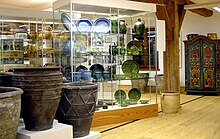Kröninger Hafnerkeramik
The products made by craftsmen in the hilly landscape of Kröning in western Lower Bavaria, rich in clay, are called Kröninger Hafnerkeramik . The high density of workshops, especially in the heyday of the 18th century, led to the distribution of the products within a radius of several hundred kilometers. The Kröninger Hafner took a leading position in the markets of the big cities . Caused by a series of unfavorable developments, the handicraft lost its importance in the first half of the 20th century and became extinct around 1930.
The tradition
The landscape of the Kröning between Landshut , Vilsbiburg and Dingolfing , with the "Hafnern im Kröning" who used to work there, is the largest center for tableware production in Bavaria. The prerequisite for the handicraft, which can be documented archivally since around 1300, but also through archaeological excavation results in the former workshops, was the clay deposits still used today and the abundance of wood (Kröninger Forest).
Importance of the pottery trade on the Kröning
In the former municipal areas of Kröning , Jesendorf, Dietelskirchen and Dirnaich an der Bina, in the heyday of the handicraft in the middle of the 18th century, over 120 masters produced high-quality, but also formally appealing utensils in a variety of shapes and colors as well as stove tiles . The high number of masters therefore logically means surplus crockery, which naturally could not be sold in the production area. Around 1800 annual production is estimated at one million pieces of tableware. It was therefore necessary to look for sales areas far from the place of manufacture.
A large area of distribution for Kröninger tableware products could be determined from delivery books, the handicraft archives preserved in the local history museum Vilsbiburg , but also from entries in the parishes of Kirchberg, Dietelskirchen and Gangkofen (for the Dirnaich branch). From written evidence of the Hafner it is known that they carried out their crockery transports on the road, on the water (from Kufstein up the Inn) and from the end of the 19th century by rail. Important sales locations and regions were Landshut , Munich, Regensburg, Linz, Salzburg, the Innviertel, South Tyrol, the Nuremberg area, the Upper Palatinate and the entire Bavarian Forest region. In 1736 43 Kröninger Hafner u. a. the Jakobi- and the Auer-Dult in Munich. So it is not surprising that in the museums of these regions cookware from the Kröning is shown, for example in the Carolinum Augusteum in Salzburg, in the open-air museum in Dietenheim near Bruneck in the Pustertal, in the museum in Bozen etc. During excavations in Salzburg, Kirchberg near Kufstein, at the castle Archaeologists found ceramic relics from the Kröning in Tyrol and Pustertal . In addition, a great deal of trade potential arose from traders from the areas mentioned, who picked up the stoneware in the Kröning with cars, carts and / or wagons in order to then sell them in their hometowns. The unhindered sale on markets in the Bavarian territory was protected by old ducal privileges. In this context, the annual court delivery of ovenware to the electoral court kitchen in Munich should not go unmentioned.
exhibition
The Vilsbiburg Local History Museum can refer to an exhibition inventory of around 900 ceramics and around 100 stove tiles and parts thanks to its collecting activities and purchasing policy, as well as the crockery that it dug and restored from workshop pits in Kröning and on the Bina. Considerable quantities of ceramics are still stored in the depot.
literature
- Grasmann, Lambert: The Hafner on the Kröning and on the Bina , Attenkofer'sche Buch- u. Art print, Straubing 2010, ISBN 978-3-936511-83-3

